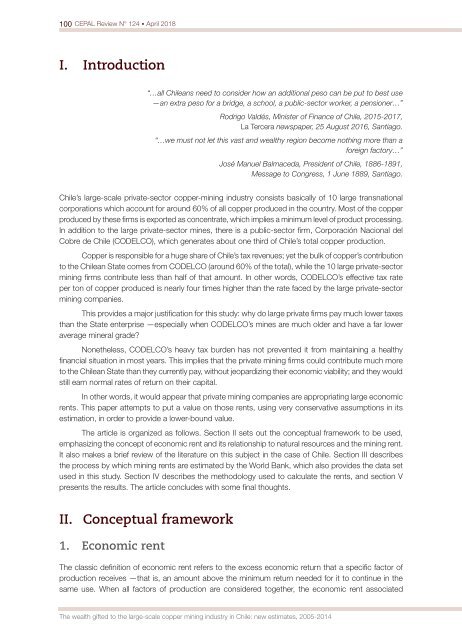CEPAL Review no. 124
April 2018
April 2018
Create successful ePaper yourself
Turn your PDF publications into a flip-book with our unique Google optimized e-Paper software.
100 <strong>CEPAL</strong> <strong>Review</strong> N° <strong>124</strong> • April 2018<br />
I. Introduction<br />
“…all Chileans need to consider how an additional peso can be put to best use<br />
—an extra peso for a bridge, a school, a public-sector worker, a pensioner…”<br />
Rodrigo Valdés, Minister of Finance of Chile, 2015-2017,<br />
La Tercera newspaper, 25 August 2016, Santiago.<br />
“…we must <strong>no</strong>t let this vast and wealthy region become <strong>no</strong>thing more than a<br />
foreign factory…”<br />
José Manuel Balmaceda, President of Chile, 1886-1891,<br />
Message to Congress, 1 June 1889, Santiago.<br />
Chile’s large-scale private-sector copper-mining industry consists basically of 10 large transnational<br />
corporations which account for around 60% of all copper produced in the country. Most of the copper<br />
produced by these firms is exported as concentrate, which implies a minimum level of product processing.<br />
In addition to the large private-sector mines, there is a public-sector firm, Corporación Nacional del<br />
Cobre de Chile (CODELCO), which generates about one third of Chile’s total copper production.<br />
Copper is responsible for a huge share of Chile’s tax revenues; yet the bulk of copper’s contribution<br />
to the Chilean State comes from CODELCO (around 60% of the total), while the 10 large private-sector<br />
mining firms contribute less than half of that amount. In other words, CODELCO’s effective tax rate<br />
per ton of copper produced is nearly four times higher than the rate faced by the large private-sector<br />
mining companies.<br />
This provides a major justification for this study: why do large private firms pay much lower taxes<br />
than the State enterprise —especially when CODELCO’s mines are much older and have a far lower<br />
average mineral grade?<br />
Nonetheless, CODELCO’s heavy tax burden has <strong>no</strong>t prevented it from maintaining a healthy<br />
financial situation in most years. This implies that the private mining firms could contribute much more<br />
to the Chilean State than they currently pay, without jeopardizing their eco<strong>no</strong>mic viability; and they would<br />
still earn <strong>no</strong>rmal rates of return on their capital.<br />
In other words, it would appear that private mining companies are appropriating large eco<strong>no</strong>mic<br />
rents. This paper attempts to put a value on those rents, using very conservative assumptions in its<br />
estimation, in order to provide a lower-bound value.<br />
The article is organized as follows. Section II sets out the conceptual framework to be used,<br />
emphasizing the concept of eco<strong>no</strong>mic rent and its relationship to natural resources and the mining rent.<br />
It also makes a brief review of the literature on this subject in the case of Chile. Section III describes<br />
the process by which mining rents are estimated by the World Bank, which also provides the data set<br />
used in this study. Section IV describes the methodology used to calculate the rents, and section V<br />
presents the results. The article concludes with some final thoughts.<br />
II. Conceptual framework<br />
1. Eco<strong>no</strong>mic rent<br />
The classic definition of eco<strong>no</strong>mic rent refers to the excess eco<strong>no</strong>mic return that a specific factor of<br />
production receives —that is, an amount above the minimum return needed for it to continue in the<br />
same use. When all factors of production are considered together, the eco<strong>no</strong>mic rent associated<br />
The wealth gifted to the large-scale copper mining industry in Chile: new estimates, 2005-2014


















